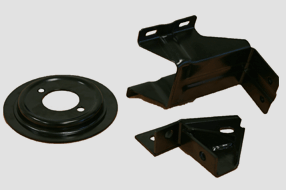A leading provider of Powder coating, E-coat, and Metal finishing services in Europe.
E-coat
Electrophoretic deposition (EPD), is a term for a broad range of industrial processes which includes electrocoating, e-coating, cathodic electrodeposition, and electrophoretic coating, or electrophoretic painting. A characteristic feature of this process is that colloidal pigments particles suspended in a liquid medium migrate under the influence of an electric field (electrophoresis) and are deposited onto an electrode.
 The process is useful for applying materials to any electrically conductive surface. electrolysis.
The process is useful for applying materials to any electrically conductive surface. electrolysis.
This process is industrially used for applying coatings to metal fabricated products and is widely used to coat automobile bodies and parts, tractors and heavy equipment, electrical switch gear, appliances, metal furniture, beverage containers, fasteners, and many other industrial products.
This process has a number of advantages:
- The process applies coatings which generally have a very uniform coating thickness without porosity.
- Complex fabricated objects can easily be coated, both inside cavities as well as on the outside surfaces.
- Relatively high speed of coating.
- Relatively high purity.
- Applicability to wide range of materials (metals, ceramics, polymers, etc.)
- Easy control of the coating composition.
- The process is normally automated and requires less human labor than other coating processes.
- Highly efficient utilization of the coating materials result in lower costs relative to other processes.
- The aqueous process which is commonly used has less risk of fire relative to the solvent-borne coatings that they have replaced.
- Modern electrophoretic paint products are significantly more environmentally friendly than many other painting technologies.
Process of Ecoat painting
The overall process of electrophoretic deposition consists of several sub-processes:
- The object to be coated needs to be prepared for coating. This normally consists of some kind of cleaning process and may include the application of a conversion coating, typically an inorganic phosphate coating.
- The coating process itself. This normally involves submerging the part into a container or vessel which holds the coating bath or solution and applying direct current electricity through the EPD bath using electrodes. Typically voltages of 25 - 400 volts DC are used in electocoating or electrophoretic painting applications. The object to be coated is one of the electrodes, and a set of "counter-electrodes" are used to complete the circuit.
- After deposition, the object is normally rinsed to remove the undeposited bath. The rinsing process may utilize an ultrafilter to dewater a portion of the bath from the coating vessel to be used as rinse material. FMF uses an ultrafilter so that all of the rinsed off materials can be returned to the coating vessel, allowing for high utilization efficiency of the coating materials, as well as reducing the amount of waste discharged into the environment.
- A baking or curing process is normally used following the rinse. This will crosslink the polymer and allows the coating, which will be porous due to the evolution of gas during the deposition process, to flow out and become smooth and continuous.
